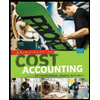
Concept explainers
Problem 19-1A
Production costs computed and recorded; reports prepared C2 P1 P2 P3 P4
Marcelino Co's March 31 inventory of raw materials is $80,000. Raw materials purchases in April are $500,000, and
| Jsb 306 | Job 307 | Job 308 | |
| Balances on March 31 | |||
| Direct materials | $ 29.000 | $ 35.000 | |
| Direct lata | 20.000 | 18.000 | |
| Applied overhead | 10,10 | 9.000 | |
| Costs during April | |||
| Direct materials | 135,000 | 220.000 | $100,000 |
| Direct lata | 85,000 | 150.000 | 105,000 |
| Applied overhead | ? | ? | ? |
| Status or April 30 | Finished (sold) | Finished (unsold) | In process |
Required
- Determine the total of each production cost incurred for April (direct labor, direct materials, and applied overhead) and the total cost assigned to each job (including the balances from March 31).
- Prepare
journal entries for the month of April to record the following.
a. Materials purchases (on credit).
b. Direct materials used in production.
c. Direct labor paid and assigned to Work in Process Inventor)7.
d. Indirect labor paid and assigned to Factor;7 Overhead.
e. Overhead costs applied to Work in Process Inventor)7.
f. Actual overhead costs incurred, including indirect materials. (Factory rent and utilities are paid in cash.)
g.
Transfer of Jobs 306 and 307 to Finished Goods Inventory.
h.
Cost of goods sold for Job 306.
i. Revenue from the sale of Job 306.
j. Assignment of any underapplied or overapplied overhead to the Cost of Goods Sold account. (The amount is not material.)
Want to see the full answer?
Check out a sample textbook solution
Chapter 19 Solutions
FUNDAMENTAL ACCOUNTING PRINCIPLES
- Which is not an objective of internal controls?A. Safeguard assetsB. Improve profitsC. Ensure accurate recordsD. Promote operational efficiency no aiarrow_forwardPlease provide the accurate answer to this financial accounting problem using appropriate methods.arrow_forwardI am searching for the accurate solution to this financial accounting problem with the right approach.arrow_forward
- 20 Nelson and Murdock, a law firm, sells $8,000,000 of four-year, 8% bonds priced to yield 6.6%. The bonds are dated January 1, 2026, but due to some regulatory hurdles are not issued until March 1, 2026. Interest is payable on January 1 and July 1 each year. The bonds sell for $8,388,175 plus accrued interest. In mid-June, Nelson and Murdock earns an unusually large fee of $11,000,000 for one of its cases. They use part of the proceeds to buy back the bonds in the open market on July 1, 2026 after the interest payment has been made. Nelson and Murdock pays a total of $8,456,234 to reacquire the bonds and retires them. Required1. The issuance of the bonds—assume that Nelson and Murdock has adopted a policy of crediting interest expense for the accrued interest on the date of sale.2. Payment of interest and related amortization on July 1, 2026.3. Reacquisition and retirement of the bonds.arrow_forward13 Which of the following is correct about the difference between basic earnings per share (EPS) and diluted earnings per share? Question 13 options: Basic EPS uses comprehensive income in its calculation, whereas diluted EPS does not. Basic EPS is not a required disclosure, whereas diluted EPS is required disclosure. Basic EPS uses total common shares outstanding, whereas diluted EPS uses the weighted-average number of common shares. Basic EPS is not adjusted for the potential dilutive effects of complex financial structures, whereas diluted EPS is adjusted.arrow_forwardPlease explain the solution to this general accounting problem with accurate explanations.arrow_forward
- I need guidance with this financial accounting problem using the right financial principles.arrow_forwardGeneral Accounting Question Solutionarrow_forwardWhich is not an objective of internal controls?A. Safeguard assetsB. Improve profitsC. Ensure accurate recordsD. Promote operational efficiencyarrow_forward
 Managerial AccountingAccountingISBN:9781337912020Author:Carl Warren, Ph.d. Cma William B. TaylerPublisher:South-Western College Pub
Managerial AccountingAccountingISBN:9781337912020Author:Carl Warren, Ph.d. Cma William B. TaylerPublisher:South-Western College Pub Principles of Cost AccountingAccountingISBN:9781305087408Author:Edward J. Vanderbeck, Maria R. MitchellPublisher:Cengage LearningPrinciples of Accounting Volume 2AccountingISBN:9781947172609Author:OpenStaxPublisher:OpenStax College
Principles of Cost AccountingAccountingISBN:9781305087408Author:Edward J. Vanderbeck, Maria R. MitchellPublisher:Cengage LearningPrinciples of Accounting Volume 2AccountingISBN:9781947172609Author:OpenStaxPublisher:OpenStax College


